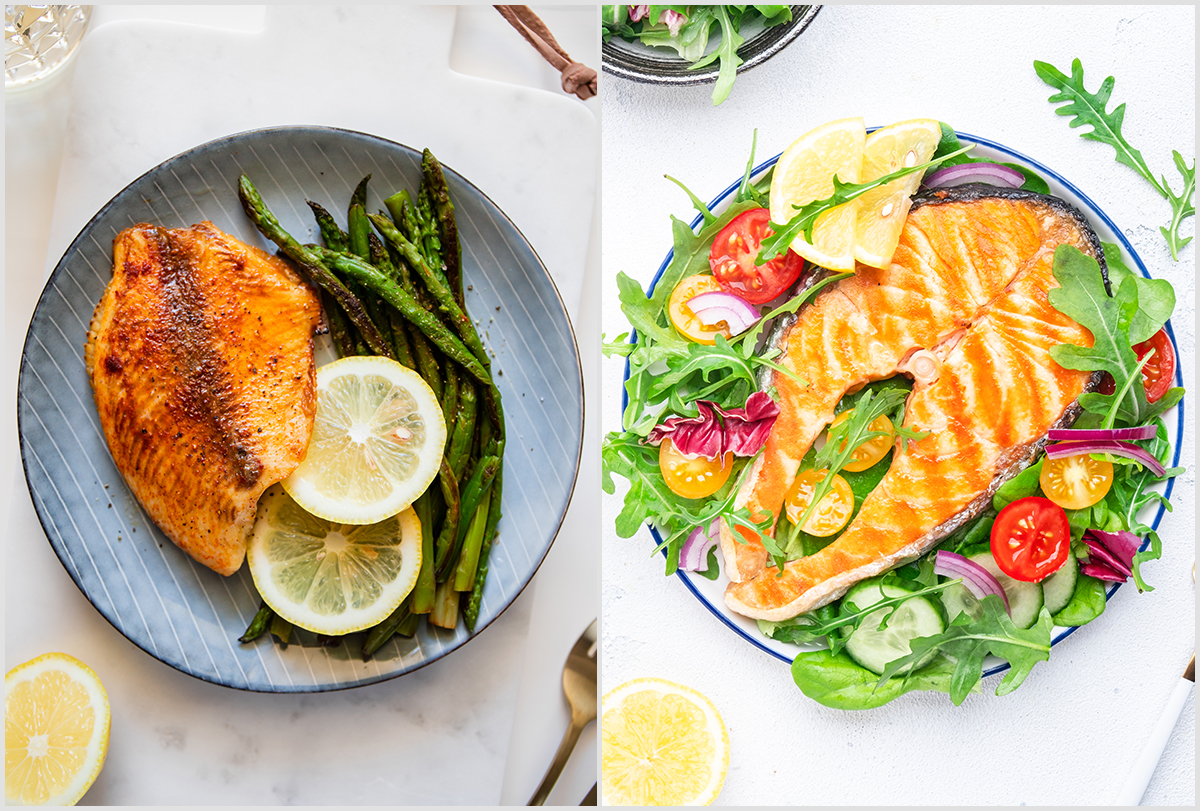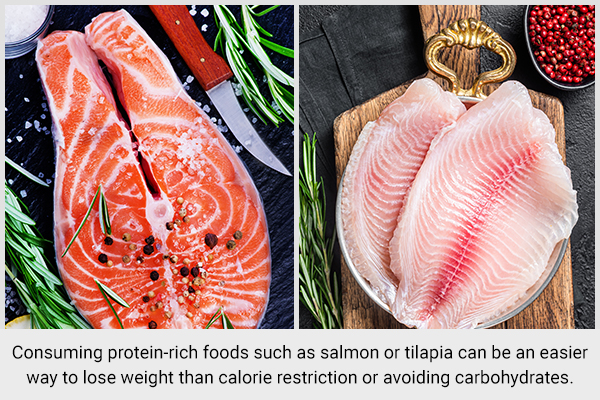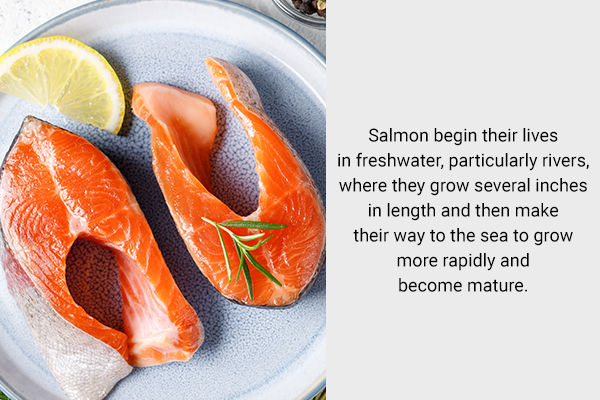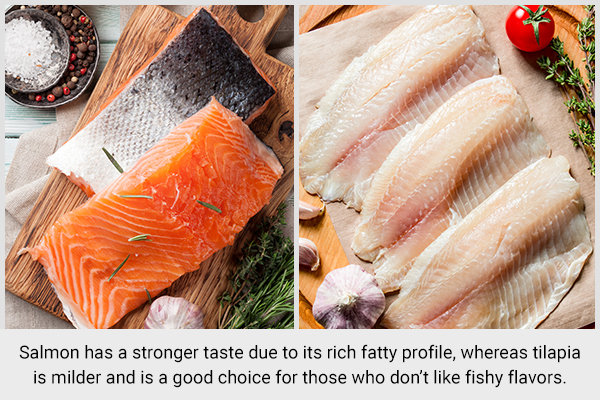In this article:
Tilapia and salmon are both essential to a seafood diet. However, based on location, availability, and cost, one or the other fish is preferred.

When it comes to their nutritional profile, both are comparable with a slight difference in their calories and fat content. Tilapia is lower in calories and fat than salmon, but otherwise, they are similar nutritionally.
The one pertinent difference between the two fishes is the omega-3 content. Salmon contains much more omega-3 fatty acids than tilapia.
In the body, omega-3 fatty acid plays a role in lowering inflammation and improving heart health. They improve the function of blood vessels, lower blood pressure, and ultimately aid in lowering cholesterol levels.
If you want to know which is healthier, the answer is “Salmon is much healthier than tilapia; although it has a higher fat content than tilapia, it has more health benefits.”
Salmon Versus Tilapia: Health Benefits
According to the following health benefits of salmon and tilapia, you may easily understand which is more suitable for you.
1. Helps with weight management and weight loss
Following a high-protein diet in weight management is the easiest and most effective strategy to control weight. (1)
Consuming protein-rich foods such as salmon or tilapia can be an easier way to lose weight than calorie restriction or avoiding carbohydrates. (2)
Both tilapia and salmon contain comparable amounts of protein. However, salmon contains 4.4 g of fat as compared to a mere 1.7 g of fat in tilapia for the same (100 g) amount. (3)(4)
This higher fat content also contributes to a higher caloric value of salmon. So, if you are on a restricted-calorie diet, tilapia may prove to be a better protein source.
Ultimately, it is up to you to decide which type of fish is best for your weight loss goals.

2. Lowers cholesterol
Out of the two fishes, salmon is a richer source of omega-3 fatty acids, (3) which are potent anti-inflammatory agents. Multiple studies have shown that consuming omega-3 fatty acids through the diet can offer benefits such as: (5)
- Lowering cholesterol and preventing its accumulation in the blood vessels.
- Improves insulin sensitivity, leading to better blood sugar management in diabetes
- Improving the flow of blood through the blood vessels
Since salmon has a higher omega-3 fatty acid content than tilapia, consuming it is better for blood cholesterol management.
3. May benefit thyroid disorders
The thyroid gland contains the most amount of selenium and produces enzymes that utilize selenium. (6)
Studies have found that a selenium deficiency can decrease thyroid function, which ultimately leads to the development of thyroid disorders such as Graves’ disease and hypothyroidism.
In such cases, supplementation with selenium can prevent the occurrence of thyroid disease, especially in the case of autoimmune thyroid disease. (7) Both salmon and tilapia contain similar amounts of selenium and can be included in the diet.
Nutritional Profile of Salmon and Tilapia
One 100 g of salmon contains 127 calories, 21 g of protein, 4.4 g of fat, and 46 mg (15% of the daily requirement) of cholesterol. It also contributes these nutrients to the diet: (3)
- 16% of the daily requirement of vitamin D
- 24% of the daily requirement of vitamin B3
- 10% of the daily requirement of vitamin B5 and B6
- 66% of the daily requirement of vitamin B12
- 14% of the daily requirement of phosphorus
- 76% of the daily requirement of selenium
- 8% of the daily requirement of copper
- 0.56 g of omega-3 fatty acids
Meanwhile, 100 g of tilapia has 96 calories, 20 g of protein, 1.7 g of fat, and 50 mg (17% of the daily requirement) of cholesterol. In addition, it contributes these nutrients to the diet: (4)
- 16% of the daily requirement of vitamin D
- 24% of the daily requirement of vitamin B3
- 10% of the daily requirement of vitamin B5 and B6
- 66% of the daily requirement of vitamin B12
- 14% of the daily requirement of phosphorus
- 76% of the daily requirement of selenium
- 8% of the daily requirement of copper
- 0.16 g omega-3 fatty acids
Physical Appearance and Taste of Tilapia and Salmon

Physical appearance
Salmon begin their lives in freshwater, particularly rivers, where they grow several inches in length and then make their way to the sea to grow more rapidly and become mature. They are found in deep seas of the Atlantic and Pacific regions. Currently, salmon is popularly consumed worldwide. (8)
Tilapia, on the other hand, is a freshwater fish local to Central and South America, the West Indies, parts of Africa, and the coastal areas of India. (9) It is bred on farms and is popularly known as aquatic chicken due to its rapid growth and ease of survival. (10)
Taste and flavor
Salmon has a red-pink flesh that turns pale when cooked. Due to its high fat content, (3) salmon has a strong taste and smell. Comparatively, tilapia has a whitish flesh and a milder taste.
Precautions and Safety With Salmon and Tilapia Consumption
The presence of heavy metals in fish such as salmon and tilapia, especially mercury, is a pressing concern. However, experts have found mercury levels in salmon and farmed tilapia to be well within the safe limits. (11)(12)
Another concern with eating salmon is the risk of developing fishborne infections associated with its raw consumption. Raw fish consumption can also lead to parasitic infections such as tapeworm and liver fluke. (13) Hence, it is better to cook fish well before eating.
Who should avoid consuming these fishes?
Generally, the consumption of fish is safe unless there is a presence of allergies.
Practical Takeaways

- Salmon and tilapia are popularly consumed fishes despite their differences in where they are found and their nutritional value. While salmon is a sea fish found in the deep seas, tilapia is a freshwater fish and is also farmed for its consumption.
- Salmon has a stronger taste due to its rich fatty profile, whereas tilapia is milder and is a good choice for those who don’t like fishy flavors.
- Salmon is higher in calories, omega-3 content, and fat than tilapia and has a similar nutrient profile when it comes to vitamin D, B3, B12, phosphorus, selenium, and copper.
- Including salmon or tilapia in the diet can aid in managing weight, lowering cholesterol levels, and even preventing thyroid disorders.
- Was this article helpful?
- YES, THANKS!NOT REALLY


